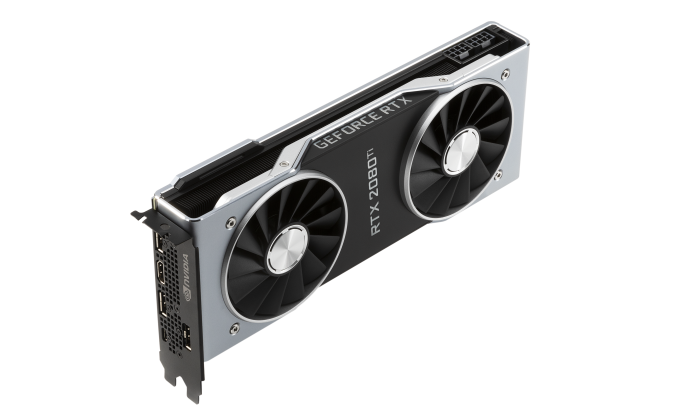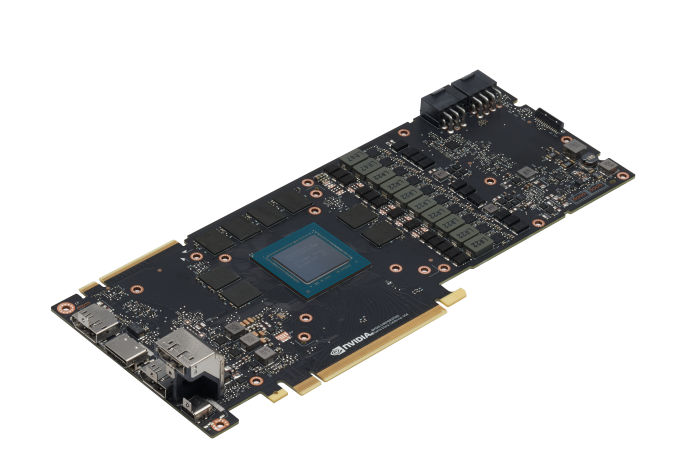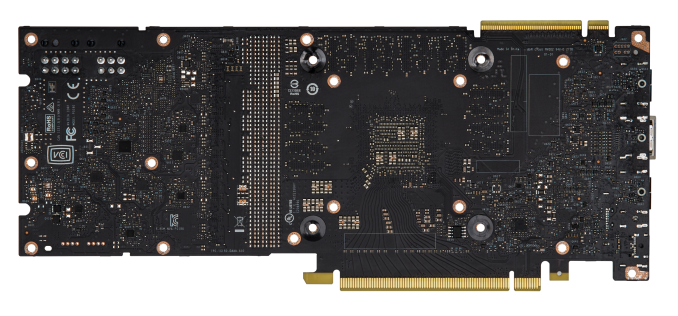The NVIDIA GeForce RTX 2080 Ti & RTX 2080 Founders Edition Review: Foundations For A Ray Traced Future
by Nate Oh on September 19, 2018 5:15 PM EST- Posted in
- GPUs
- Raytrace
- GeForce
- NVIDIA
- DirectX Raytracing
- Turing
- GeForce RTX
Meet The GeForce RTX 2080 Ti & RTX 2080 Founders Editions Cards
Moving onto the design of the cards, we've already mentioned the biggest change: a new open air cooler design. Along with the Founders Edition specification changes, the cards might be considered 'reference' in that they remain a first-party video card sold direct by NVIDIA, but strictly-speaking they are not because they no longer carry reference specifications.
Otherwise, NVIDIA's industrial design language prevails, and the RTX cards bring a sleek flattened aesthetic over the polygonal shroud of the 10 series. The silver shroud now encapsulates an integrated backplate, and in keeping with the presentation, the NVLink SLI connectors have a removable cover.
Internally, the dual 13-blade fans accompany a full-length vapor chamber and component baseplate, connected to a dual-slot aluminum finstack. Looking at improving efficiency and granular power control, the 260W RTX 2080 Ti Founders Edition features a 13-phase iMON DrMOS power subsystem with a dedicated 3-phase system for the 14 Gbps GDDR6, while the 225W RTX 2080 Founders Edition weighing in with 8-phases main and 2-phases memory.
As is typical with higher quality designs, NVIDIA is pushing overclocking, and for one that means a dual 8-pin PCIe power configuration for the 2080 Ti; on paper, this puts the maximum draw at 375W, though specifications-wise the TDP of the 2080 Ti Founders Edition against the 1080 Ti Founders Edition is only 10W higher. The RTX 2080 Founders Edition has the more drastic jump, however, with 8+6 pins and a 45W increase over the 1080's lone 8 pin and 180W TDP. Ultimately, it's a steady increase from the power-sipping GTX 980's 165W.
One of the more understated changes comes with the display outputs, which thanks to Turing's new display controller now features DisplayPort 1.4 and DSC support, the latter of which is part of the DP1.4 spec. The eye-catching addition is the VR-centric USB-C VirtualLink port, which also carries an associated 30W not included in the overall TDP.
Something to note is that this change in reference design, combined with the seemingly inherent low-volume nature of the Turing GPUs, cuts into an often overlooked but highly important aspect of GPU sales: big OEMs in the desktop and mobile space. Boutique system integrators will happily incorporate the pricier higher-end parts but from the OEM’s perspective, the GeForce RTX cards are not just priced into a new range beyond existing ones but also bringing higher TDPs and no longer equipped with blower-style coolers in its ‘reference’ implementation.
Given that OEMs often rely on the video card being fully self-exhausting because of a blower, it would certainly preclude a lot of drop-in replacements or upgrades – at least not without further testing. It would be hard to slot into the standard OEM product cycle at the necessary prices, not to mention the added difficulty in marketing. In that respect, there is definitely more to the GeForce RTX 20 series story, and it’s somewhat hard to see OEMs offering GeForce RTX cards. Or even the RT Cores themselves existing below the RTX 2070, just on basis of the raw performance needed for real time ray tracing effects at reasonable resolutions and playable framerates. So it will be very interesting to see how the rest of NVIDIA’s product stack unfolds.
















337 Comments
View All Comments
AnnoyedGrunt - Friday, September 21, 2018 - link
I think it was actually much less, judging by comments made in one of the reviews I linked. Maybe around $350 or so, which was very expensive at the time. It is true that it was a revolutionary card, but at the same time it was greeted with a lukewarm reception from the gaming community. Much like the 20XX series. I doubt that the 20XX will seem as revolutionary in hindsight as the GeForce256 did, but the initial reception does seem similar between the two. Will be interesting to see what the next year brings to the table.-AG
eddman - Friday, September 21, 2018 - link
Wow, that's just $525 now. I'm interested in old card prices because some people claim they have always been super expensive. It seems they have a selective memory. I'm yet to find a card more expensive than 2080 Ti from that time period.I'm not surprised that people still didn't buy many 256 cards. The previous cards were cheaper and performed close enough for the time.
abufrejoval - Thursday, September 20, 2018 - link
I am pretty sure I'll get a 2080ti, simply because nothing else will run INT4 or INT8 based inference with similar performance and ease of availability and tools support. Sure, when you are BAIDU or Facebook, you can buy even faster inference hardware or if you are Google you can build your own. But if you are not, I don't know where you'll get something that comes close.As far as gaming is concerned, my 1080ti falls short on 4k with ARK, which is noticeable at 43". If the 2080ti can get me through the critical minimum of 30FPS, it will have been worth it.
As far as ray tracing is concerned, I am less concerned about its support in games: Photo realism isn't an absolute necessity for game immersion.
But I'd love to see hybrid render support in software like Blender: The ability to pimp up the quality for video content creation and replace CPU based rander farms with something that is visually "awsome enough" points towards the real "game changing" capacity of this generation.
It pushes three distinct envelopes, raster, compute and render: If you only care about one, the value may not be there. In my case, I like the ability to explore all three, while getting an 2080ti for me allows me to push down an 1070 to one of my kids still running an R290X: Christmas for both of us!
mapesdhs - Thursday, September 27, 2018 - link
In the end though that's kinda the point, these are not gaming cards anymore and haven't been for some time. These are side spins from compute, where the real money & growth lie. We don't *need* raytracing for gaming, that glosses over so many other far more relevant issues about what makes for a good game.Pyrostemplar - Thursday, September 20, 2018 - link
High performance and (more than) matching price. nVidia seemingly put the card classification down one notch (x80 => x70; Ti => x80; Titan => Ti) while keeping the prices and overclocked then from day one so it looks like solid progress if one disregards the price.I think it will be a short lived (1 year or so) generation. A pricey stop gap with a few useless new features (because when devs catch up and actually deploy DXR enabled games, these cards will have been replaced by something faster).
ballsystemlord - Thursday, September 20, 2018 - link
Spelling/grammar errors (Only 2!):Wrong word:
"All-in-all, NVIDIA is keeping the Founders Edition premium, now increased to $100 to $200 over the baseline"
Should be:
"All-in-all, NVIDIA is keeping the Founders Edition premium, now increased from $100 to $200 over the baseline"
Missing "s":
"Of course, NVIDIA maintain that the cards will provide expected top-tier"
Should be:
"Of course, NVIDIA maintains that the cards will provide expected top-tier"
Ryan Smith - Thursday, September 20, 2018 - link
Thanks!ballsystemlord - Thursday, September 20, 2018 - link
Nate! Can you add DP folding @ home benchmark numbers? There were none in the Vega review and only SP in this Nvidia review.SanX - Thursday, September 20, 2018 - link
Author thinks that all gamers buy only fastest cards? May be. But I doubt all of them buy the new generestion card every year. In short, where are comparisons to 980/980Ti and even 780/780Ti? Owners of those cards are more interested to upgrade.milkod2001 - Friday, September 21, 2018 - link
See from top menu on right, there is a bench where you can see results. I presume they add data to huge database soon. And yes,people are talking about high end GPU but most are spending $400 max. for it.